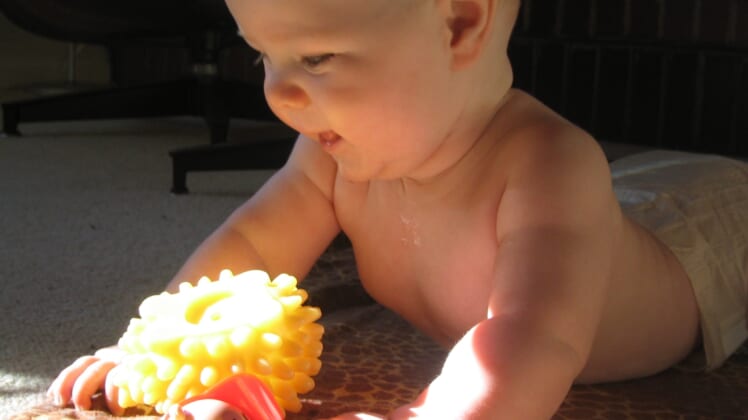
We never thought about toy safety when you found the toy treasures in childhood, however, we remember these treasures all our lives. This is one reason to choose your child’s toys with care; the other is safety. Consider these guidelines when choosing toys, and share them with anyone who may be buying gifts for your child:
How can I make sure my child’s toys are safe?
Pick toys suited to your child’s developmental level.Most bear a “recommended age” sticker, which should be used as a starting point while shopping. Be realistic about your child’s abilities and level of maturity when choosing a toy that’s appropriate for his age. Toys that have projectiles, for example, are never suitable for a child under the age of 4 — and even some 6-year-olds aren’t mature enough to handle them. Likewise, if your 3-year-old still puts everything in his mouth, continue to steer clear of toys and games with small parts and pieces.
Think Big When Thinking Toy Safety.
Until your child turns 3, everything he plays with should be bigger than his mouth to limit the risk of choking. The U.S. Consumer Product Safety Commission has designed a small-objects tester you can use to determine if a toy could cause choking. If a toy or a loose part can fit inside the test cylinder, it’s not safe. The testers are widely available at a variety of stores, from supermarkets to toy stores to hardware stores, and cost only a couple of dollars. (A cardboard tube from a roll of toilet paper works well, too.) When buying for a child under 3, avoid marbles and balls with a diameter of 1.75 inches or less.
Beware of balloons, a leading cause of toy-related deaths.
Children under 8 can easily inhale balloons. Remember, an inflated balloon is just one pop away from becoming a choking hazard.
Pass on a toy that’s too heavy
Your child could be harmed if it fell on him.
Look for toys that are well made.
Paint shouldn’t peel. Tails of stuffed animals should be securely sewn, and their seams should be reinforced. Since toddlers like to poke and pull at toys, examine all playthings for any buttons, batteries, ribbons, eyes, beads, or plastic appendages that could easily be chewed or snapped off and swallowed. Check toys for glass, sharp edges, and points as well.
Watch out for strings or cords longer than 12 inches.
They can easily wrap around a young child’s neck and lead to strangulation.
Look for children’s art sets and crayons that are marked “ASTM D-4236.”
This means that a toxicologist has reviewed the toy and added warning information, if necessary.
Always buy a helmet if you give your child a bicycle, skates, or skateboard, and make sure he wears it.
Start the habit early by having him wear a helmet when he rides his first tricycle. (But have him remove it as soon as he gets off the bike: The straps are a strangling hazard on playground equipment.)
Be particularly vigilant about toy safety with older toys, such as the ones you might find at a yard sale.
For example, the 5-year-old model of a popular play kitchen has a phone attached with a potentially deadly cord, but the latest model of the same toy has a more current — and safer — cordless phone. Check your child’s toys regularly to see if they’re broken, and if so, repair them or throw them away.
Ask yourself if your child is physically ready for a toy you want to purchase.
For example, parents with older children often buy a bike one size too big to avoid buying a new one the next year. That tactic can lead to serious injury since the child doesn’t have the physical skills to safely control the bigger bike.
Teach older children about toy safety and to keep their toys away from their younger brothers and sisters.
Don’t let kids play with adult darts or other sports equipment with sharp points, and test dart guns to make sure they can’t fire objects — such as nails — that an enterprising child might stuff in them.
Avoid any toys that use small button magnets: they can cause injury and even death if swallowed.
These can be found in everything from musical greeting cards to refrigerator magnets, so make sure they are out of reach of small children. Better yet, don’t keep them in your house.
Further Resources
U.S. Consumer Product Safety Commission
800-638-2772
http://www.cpsc.gov/
For further information and lists of recalled toys, visit the U.S. Consumer Product Safety Commission website.
References
U.S. Consumer Products Safety Commission. October 29, 2010. http://www.cpsc.gov/
The American Academy of Pediatrics, Caring for Your Baby and Young Child: Birth to Age 5. Bantam, 1998.
William Sears et al, The Baby Book: Everything You Need to Know About Your Baby from Birth to Age Two, Little, Brown & Co., 2003.
Last Updated: March 11, 2015
Children’s Health Health Library Copyright ©2015 LimeHealth. All Rights Reserved.
